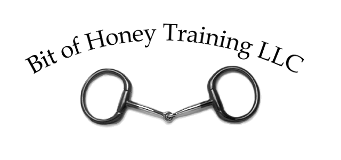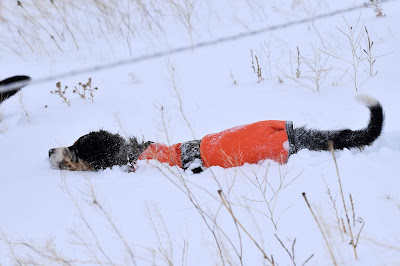Rizzo also had not been properly crate trained by her previous two adopters (yes, she was returned twice to the rescue). It appears that they would stuff her in a crate when they were leaving, but never really taught her that it was her safe place, a private bedroom, and her refuge when she needed some "me" time. By the time I got her she was extremely anxious when confined in a crate, even destroying a wire one, shredding any bedding I would put in her plastic one, and making terrible torturous noises at an ear splitting pitch. This would go on for hours, and while Miles could get her to be quiet, once Miles was gone she had no one to give her rules and structure when alone in the crate.
We combated the noise by letting her hang out loose in the heated garage at night, and she was fine with that. She had a fluffy dog bed made from my old barn jeans on a bench that she snuggled into each evening, and she seemed quite content with that setup. However, being loose and being such a bouncy dog, she would also hop up onto the cars in the garage when they were parked there. We didn't want scratches on the cars, but we didn't want her screaming, either.
I did some brainstorming and recognized that Rizzo seemed to feel safest when she was up high. She has many cat-like behaviors and traits, and this is one of them.
While we're in the barn, her preference is to nap on the top of the hay stack while I'm tacking up horses, and she often can be found hanging out on the top of the big round bales stored outside.
Rizzo recently taught Pascal how to climb to the top of the bales as well, and now the two of them enjoy romping around at heights hitherto uncharted for dogs of this small stature!
To tap into this love of heights, I decided to stack the dog crates on top of one another. Perhaps part of Rizzo's anxiety at being confined in the crate was that being so low to the ground she didn't feel safe with no escape from potential or imaginary threats at ground level? To make the height and new location extra fun, I positioned the dog food tub in a way that she can hop up on it and then into her crate, since she really loves jumping around at heights. Perhaps she was a skydiver in a past life.
I also took her favorite dog bed from the bench (seen here just outside the kennel behind the crates) and placed it in her crate. Putting her bed there created an association of safety and comfort in the crate, which also felt safer since it was now up high, and all her meals and treats are given to her in the back of the lifted crate. How could she resist a kong toy filled with peanut butter and kibble, placed on her favorite bed, lifted up to a safe height, and with an open door so she can come and go as she pleases? It additionally gives her a spot to escape Pascal's constant poking and requests to play.
After wiring the kennel in such a way that the mesh can't be pulled away from the bottom of the frame, I placed all the tasty treats in their designated locations, put both dogs in the kennel, and voila'! Rizzo now likes her crate and will happily go in to eat dinner, escape Pascal, and there is no stressful vocalization.
Our next issue as Rizzo gains confidence is that she has begun wandering. When Miles was here he made it clear that she was to remain in the barn or with me, that was her job. Now that Miles is gone, and Pascal has arrived as a partner in crime, Rizzo has gotten bolder. Unfortunately they are too close in age to really have the mentor/protege' relationship, and the dynamic has become one of two puppies acting as stupid kids having fun rather than focusing on the task at hand. The reason I have these dogs is to help me train the horses, and if they are running around at the neighbors' properties they're not helping.
When I was working at vet clinics we would always caution people against getting two pups from the same litter, precisely because of this issue. They tend to bond to each other and do things together instead of with the human. I'd hoped that Rizzo and Pascal were far apart enough in age to avoid it, but no luck. As a result, they each have gone into individual training with me. Once each dog is extremely reliable on their own with commands and responsibilities I'll return to training them together, but in the meantime each dog has a day (or half day) with me while the other hangs out in the kennel.
So far this is working really well. During Pascal's training sessions he sticks close by me, or hangs out in the barn waiting for me to return with a horse. He likes all sorts of training treats, so watches me closely and tries all kinds of good dog behaviors to earn attention and goodies. Sit, down, c'mere, this way, watch it, up, leave it, are all commands he seems to have figured out and consistently responds to. The only difficulty with him is that it's hard to get things accomplished when I'm continually interrupted for puppy snuggles.
Rizzo also is making good progress, though she's returned to on-leash training for the time being. When doing barn chores she is tethered to me by attaching her leash to my belt, or when I'm handling a horse and the leash is a safety hazard she is tied out of the way to the wall of the barn, arena, or stall. I've also gotten my remote training collar back from being repaired so we have begun aversion training regarding the cats, the road, and the property line. It's a very effective training tool when used correctly as negative reinforcement in conjunction with positive reinforcement, though it can be disastrous if used incorrectly. Getting the timing just right can be tricky, so I don't recommend these collars to people unless they have been properly trained by a professional on how to use it. That includes introducing it to the dog with assessing the proper stimulation level for that individual animal, and correctly applying the training progression.
The gist of the remote collar training process is that I have Rizzo on a 30' line so she can wander around and make her own choices. If she goes near the fence line on the edge of the property I call her back, then give her a treat (so far the favorite is a small taste of American cheese). If she doesn't come right away I can reel her in with the line. If she is ignoring me because she's overly distracted and aiming to go through the fence, I use my remote and hit the button that causes the collar to vibrate at her throat. She is such a smart and sensitive dog that this acts as plenty of stimulation to cause her to avoid the fence (or cat, or road) and return to me, her safe person, for a treat. We have been on several long walks, and after receiving a vibration at the fence when her nose crossed the line, or when she lifted a paw to cross it, she has definitely decided it's safer and better to stay well within our side of the line.
This has worked well for teaching her to avoid the cats, too. A couple brief sessions during which she got a vibration when she darted towards the cats has helped her realize that it's much better to come to me and have some cheese when she's tempted by a cat, rather than press forwards toward them and become uncomfortable.
There are many additional settings on the collar, but I almost never use anything other than the vibration. Especially on a sensitive dog like Rizzo it would do so much more harm than good to use the stronger settings, and it would completely derail the positive associations she has with me and working outside. An intelligent dog will also figure out that there is one set of rules while wearing the collar and that those rules may not apply without the collar, so it's extremely important to use this training tool consistently and in a way that the dog never connects the vibration to the collar, but only believes the fence/cat/road is causing the discomfort. That's why it's much better to learn to use one of these collars from a professional in lessons rather than think the collar itself is a "fix all". It's only as effective as the trainer using it.
Gradually Rizzo will return to off leash work as she resumes sticking with me reliably, and eventually both she and Pascal will be working together off leash. This is a process, however, and the most important piece is keeping both dogs confident, enjoying their work, and looking to me for instruction rather than each other for entertainment. I do love these dogs, and I know the amazing potential they have to be excellent horse-training dogs. That's why it's critical that I train them correctly so that they become reliable and helpful, and thankfully during winter months I have the chance to do it!




































































































































